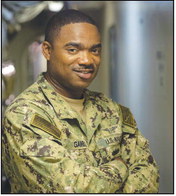West Memphis native takes Marines to the fight aboard U.S. Navy Warship

Gamble traveling the world while serving his country
By Senior Chief Mass Communication Specialist William Lovelady
Navy Office of Community Outreach SAN DIEGO – Petty Officer 1st Class Zachariah Gamble, a native of West Memphis, Arkansas, joined the Navy to get away and travel the world. Now, 12 years later, Gamble serves aboard one of the Navy’s amphibious ships at Naval Base San Diego.
“We’ve got a good ship,” said Gamble. “Life is good.
I’ve been a carrier sailor so this is a new experience for me.”
Gamble, a 2006 graduate of Marion High School in Marion, Arkansas, is an aviation boatswain’s mate handling aboard USS Essex, one of four Wasp-class amphibious assault ships in the Navy, homeported in San Diego.
“I’m the leading petty officer for V-1 division so I have 65 sailors reporting to me,” said Gamble. “We launch and recover aircraft. We also do crash and salvage, putting out fires and rescuing pilots.”
Gamble credits success in the Navy to many of the lessons learned in West Memphis.
“I was working at a young age,” said Gamble. “My daddy had his own business and he put us to work early, so the Navy was easy. You work hard, you get advanced.”
Essex is designed to deliver U.S. Marines and their equipment where they are needed to support a variety of missions ranging from amphibious assaults to humanitarian relief efforts. Designed to be versatile, the ship has the option of simultaneously using helicopters, Harrier jets, and Landing Craft Air Cushioned (LCAC), as well as conventional landing craft and assault vehicles in various combinations.
Because of their inherent capabilities, these ships have been and will continue to be called upon to support humanitarian and other contingency missions on short notice.
Sailors’ jobs are highly varied aboard Essex. More than 1,000 men and women make up the ship’s crew, which keeps all parts of the ship running smoothly, from handling weaponry to maintaining the engines. An additional 1,200 Marines can be embarked.
“Working with Marines on board, you learn patience,” said Gamble. “We have to coexist with other service members who have different ways of doing things.”
Serving in the Navy means Gamble is part of a world that is taking on new importance in America’s focus on rebuilding military readiness, strengthening alliances and reforming business practices in support of the National Defense Strategy.
America is a maritime nation, and the nation’s prosperity is tied to the ability to operate freely on the world’s oceans. More than 70 percent of the Earth’s surface is covered by water; 80 percent of the world’s population lives close to a coast; and 90 percent of all global trade by volume travels by sea.
“Our priorities center on people, capabilities and processes, and will be achieved by our focus on speed, value, results and partnerships,” said Secretary of the Navy Richard V. Spencer. “Readiness, lethality and modernization are the requirements driving these priorities.”
Though there are many ways for sailors to earn distinction in their command, community, and career, Gamble is most proud of going to the Department of Defense fire academy. “I was an instructor so while I was there, I was able to get all my certifications,” said Gamble. “That will set me up for my next career as a firefighter anywhere I want to go.”
As a member of one of the U.S. Navy’s most relied upon assets, Gamble and other sailors know they are part of a legacy that will last beyond their lifetimes contributing to the Navy the nation needs.
“Serving in the Navy means protection of this country,” said Gamble. “I’m doing my part because not everyone is able to do this.”



Share